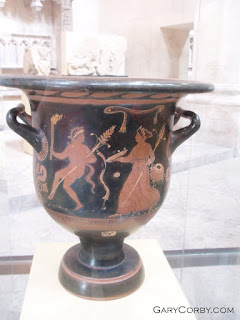Gary Corby, first off love your website ;). (You can see at once Edward is a man of fine taste - Gary). A polisher of stone, or a stone mason/sculptor, I was wondering do you have more information. "Polisher of stone" was it a name given to many or only the select few?Edward's referring here to the description on my web site of the father of Socrates being a "polisher of stone," and by extension Socrates too.
"Polisher of stone" in Greek meant not so much a stone mason as a sculptor in stone, and marble in particular.
Though it is common belief, it is only by tradition that Sophroniscus, the father of Socrates, was a "polisher of stone." (The Classical Greek term is lithoxoos).
The first documented mention I know of the idea is more than a hundred years after Socrates' death. There is no real evidence contemporary with Socrates himself; neither Plato nor Xenophon mention the profession of either Sophroniscus or Socrates.
I have Sophroniscus as a sculptor in my novels because it suits me, and if I didn't I would have to explain it away for all those people who take the story as true.
Plato does in one of his books have Socrates claiming Daedalus as his ancestor. The way Plato puts it reads to me like Socrates was passing on a family tradition which he accepted as true.
Daedalus is famous as the mythical genius artisan who worked for King Minos of Crete, who helped Theseus when he came to slay the Minotaur, and who invented wings which his son Icarus used to fly too close to the sun, thus creating the world's first airflight disaster. Daedalus is said to have returned to Athens with Theseus, and Socrates claiming him as an ancestor is fair evidence that Socrates comes from the artisan class.
This in itself is odd because it seems certain Sophroniscus had friends in common with Pericles and his father Xanthippus, which you would not expect if the family were artisans. Artisans were middle class; anyone hanging out with Pericles' family would be seriously upper class.
"Polisher of stone" was not necessarily a compliment! At the time of my detective hero Nicolaos, and his irritating younger brother Socrates, the latest fashion in sculpting was not marble, but bronze. People these days think of marble when they imagine Greek sculpture, but that's because some marble work has survived and almost all the bronzework was destroyed long ago. Anyone still working in marble around 460 B.C. was either a traditionalist (which is how I've portrayed Sophroniscus) or else didn't have the greater technical skill required to work in trendy bronze.
So in summary, "polisher of stone" was the Greek term for a marble sculptor, and tradition says Socrates' family was in that business, though no one really knows.










